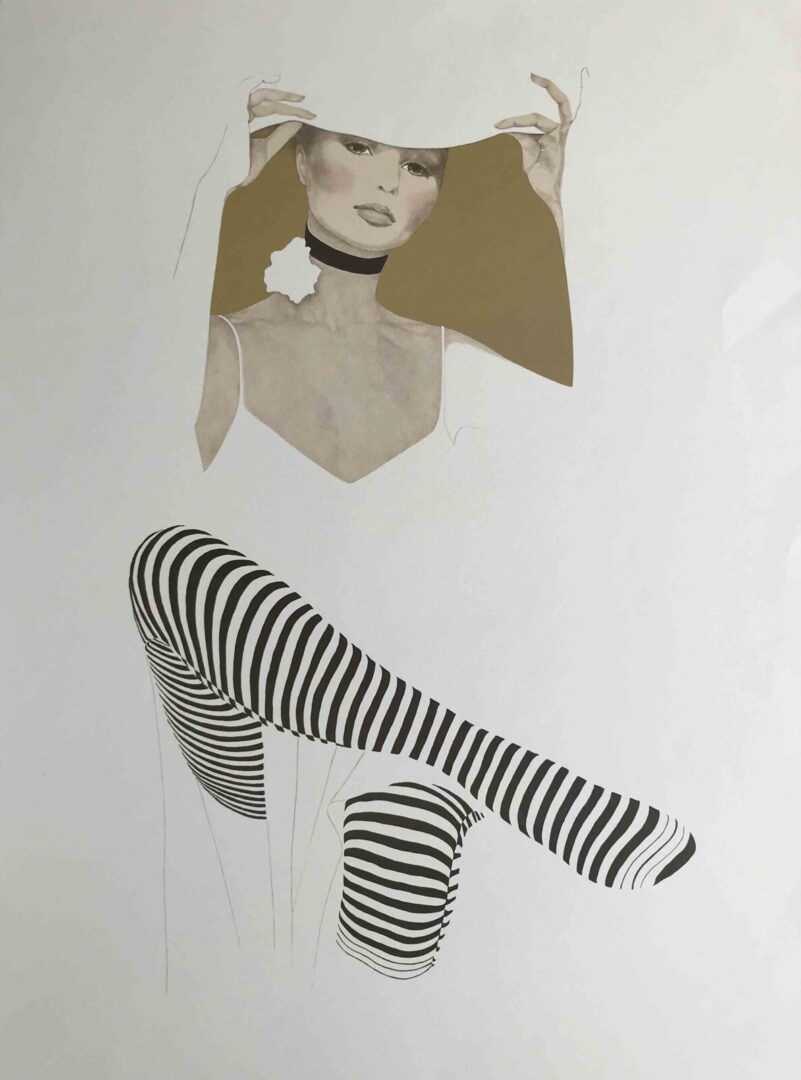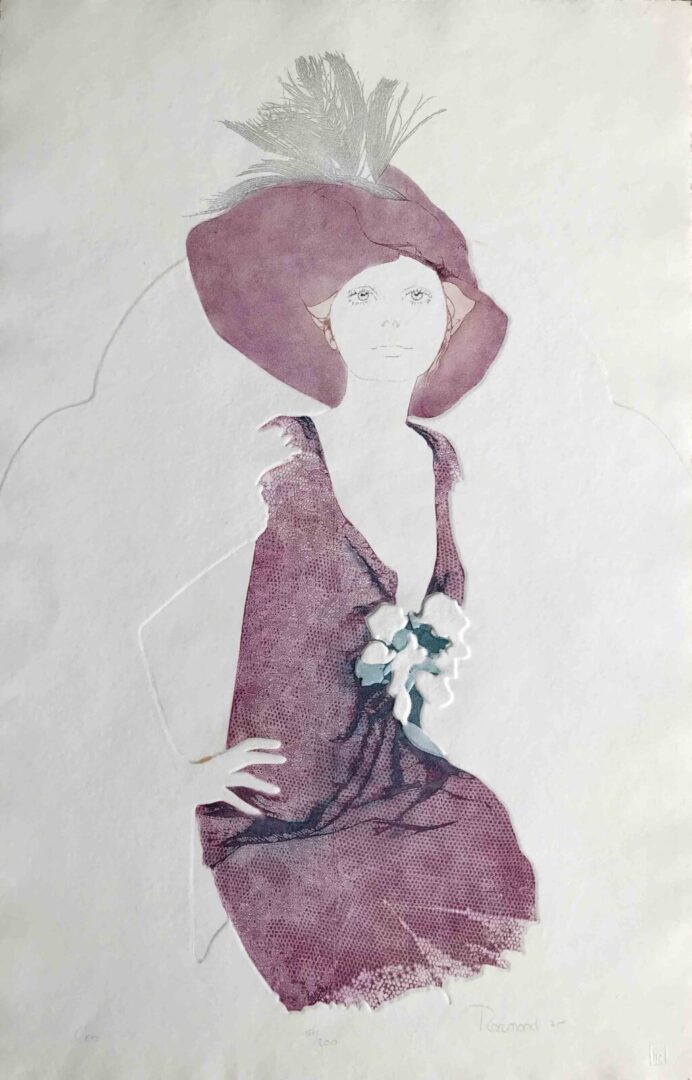Full Artist Bio
From simple sketches in pencil to finely detailed watercolors and oils, this comprehensive collection provides a rare opportunity to experience the breadth of Christine Rosamond’s work. It also gives us a chance to understand the artist behind the work and see her evolve from a teenager, struggling to balance her need for expression with her fear of what her art might reveal, to a self-actualized woman, strong enough to make peace with her past and surrounded herself with the people she loved.
THE BEGINNING: Oakland, California
If Christine’s parents had embraced her talent, there might be existing works from her childhood, but this was not to be. Fearing that Christine would steal her brother’s spotlight as the family artist, Christine’s mother, Rosemary, forbade Christine to draw at home. The only time she could express herself was at school or in her closet, by flashlight, when everyone else was asleep. Though we don’t have images to prove it, Christine’s kindergarten teacher has said that, by age five, Christine was already drawing with adult skill. She can remember Christine’s pictures of animals having near perfect detail and perspective.
In addition to oppressing Christine artistically, Rosemary also dominated Christine with physical violence. Trying to support four children with only a high school education and little help from her alcoholic husband, Rosemary was often enraged. She took this rage out on Christine and Christine’s earliest known works reflect it. In Teenage Drawing II, her subject is reticent and withdrawn. In Teenage Drawing III, the woman looks shocked and angry.
OVERNIGHT SENSATION: Los Angeles, California
After a failed marriage and the birth of her daughter Shannon, Christine fell in love with Scott Hale, an ambitious and demanding lighting designer. Recognizing Christine’s talent, Scott invited her to move in with him so that she could concentrate on her art. Feeling encouraged for the first time, Christine was able to paint with a bold new energy. A year later, at Scott’s insistence, Christine showed a number of these portraits at the 1972 Westwood Art Fair. Recognizing a fresh voice, art dealer Ira Kaplan bought out the collection and commissioned Christine to create an additional painting for him every week thereafter.
In journal entries, Christine articulated that, for her, painting was not only a means to a better life, it was also a way to prove that Rosemary could no longer control her. This rebellious energy is what I believe led to Christine’s success and can be seen in her now classic portraits: Summer Mood, Denim and Silk, and Simone. As defiant as they are beautiful, the penetrating eyes in each of these paintings tell the viewer that times have changed. Women are standing up for themselves and taking their power. Right in step with the ‘70’s feminist zeitgeist, the public – especially women – identified with this combination of strength and beauty and bought millions of Christine’s prints.
The rebellious energy that gave Christine her success would also, in the end, foil her relationship with Scott. Already a drinker, Christine started consuming more alcohol to quiet her fears and anxiety. But the drinking made things worse. Every time Christine got drunk, she would become convinced that Scott didn’t love her and would fly into a rage. Even though Scott adored Christine and was deeply bonded with Shannon, the attacks were too much for him and he ended the relationship. Christine was devastated by this loss; though, as we can see in Mother and Child, she was even more concerned that the break up was hurting Shannon.
FAME: New York, New York
In an attempt to elevate her work from mass merchandise to fine art, Christine started making lithographs for Jack Solomon and found herself falling for a fine art printer who was married. Older and more mature, the printer knew how to make Christine feel safe and appreciated. We can see that as Christine softened during this time, her subjects softened as well (Autumn) We can also see Christine becoming more technically proficient as she captured her subjects with greater detail (Victoria ) and emotional depth (Contemplation). Perhaps the longer that Christine was away from Rosemary’s tyranny, the better able she was to connect to her own self and, as she healed, her subjects became more complete.
Besides being a happy and productive time for Christine, this was also her most successful period. With the meteoric sales of these lithographs, Christine became the most published artist in the world, eclipsing even Norman Rockwell, Salvador Dali, and Alexander Calder. Unfortunately, this joyous time would not last. Tristesse expresses the sense of longing that Christine felt as she began to realize that her married lover was ultimately unattainable.
FREEDOM & DESPAIR: Encino, California
In a moment of vulnerability, Christine reconnected with Rosemary and allowed her mother to introduce her to actor Rick Partlow. Rick was attentive and charming and soon Christine was swept off her feet. Galletea and The Ascent reflect this dreamy, romantic energy. Not long after their wedding, Rick tired of Christine’s rigid schedule and persuaded her to leave Ira Kaplan and let him manage her career. After four years of strict deadlines, Christine was so exhausted, she agreed. However, without a rudder to keep her steady, she soon found herself in the undertow of Rick’s never ending parties, drinking and cocaine use.
After giving Rick more than a year to build the business, Christine saw that he still had no viable way to distribute her work. She also saw that he was draining her bank accounts and, if she didn’t leave him, she and Shannon would soon be bankrupt. As her frustration with the relationship climaxed, Christine created Crescendo: a woman who’s been so twisted and manipulated she’s ready to break.
INTROSPECTION: Monterey, California
Soon after her divorce, Christine met and married the famous muralist, Garth Benton. Garth was deeply involved with Jungian psychology and encouraged Christine to use meditation to mine her subconscious for new images. As Christine painted these images, Garth would title and interpret them. According to Garth, in Off The Wall, since Christine was painfully shy in public, her subconscious was advising her to stop blending in with the background and allow her true self to be recognized. Fatal Position was a warning that she would only find her fortune if she pulled herself out of the fetal position. Bus Stop was showing Christine that there were two sides of her – her conscious and unconscious self – and that if she wanted to be whole, she would have to find a balance between the two.
Though Garth believed these images to be Christine’s best, the public didn’t agree and sales were disastrous. Humiliated by the response, Christine returned to the style that had served her in the past. Working with fine art printers in Paris, Christine again created beautiful, defiant women like Dimanche and Dominique.
Though Christine had stopped the meditations, Garth continued to encourage her to dig into her subconscious. He believed that there was unexamined trauma that needed her attention. As if on cue, the universe cooperated and Christine’s father, Vic, who had left the family when Christine was eleven years old, returned to reacquaint himself with his daughter. Within months, Vic molested a teenage girl. The moment that Christine heard of the attack, she knew that this was not the first time Vic had transgressed. Childhood memories of being violated came flooding back to her.
This epiphany was too much for Christine. Aware that she had a problem with alcohol, she’d been abstaining throughout her marriage to Garth. But now, she needed an anesthetic and started drinking with a vengeance. She also decided that all men were capable of abusing their daughters and, fearing that Garth might hurt their seven-year-old daughter, Drew, she asked him for a divorce.
HEALING AND REBIRTH
Recognizing that she needed help, Christine started attending AA meetings and got truly sober for the first time. Without Garth to run her business, Christine brought in a number of women including her sister Vicki to help. It’s no coincidence that after almost exclusively painting solitary subjects for more than two decades, Christine started to surround her central figures with supportive women.
The Travelers is the first work that shows this sense of camaraderie. When she started to sketch the piece, her first instinct was to lean the three women against their luggage (The Travelers Baggage. In what now seems like a symbolic move, Christine decided to pull the suitcases out of the painting and, in effect, leave the women’s baggage behind.
In the completed work we see today the women appear, as if after a long journey, to be leaning on each other and, while the central figure’s companions are sleeping, the central figure is awake and composed. Perhaps after repressing the truth of her childhood for so many years, Christine was announcing with this work that she was no longer asleep or frozen in time. Emboldened by the truth, she could now move forward and go places.
A year later, Christine created Storyteller I, in which a female narrator tells six other women what looks like a serious and shocking story. One wonders if this might be Christine unburdening herself of the family secret. Given the fact that Christine included her daughter Shannon, and her stepdaughter Bree, in this image, it is also possible that Christine is warning the next generation to stay away from the family predator.
The year 1992 marked yet another shift in Christine’s work. As she continued to heal, she created First Bloom which I believe symbolized a rebirthing for her. This energy continued over the next two years as she created the most celebratory images of her career: Russian Dancers, Cienna and Celeste. In early 1994, Christine brought these jubilant images to the Art Expo in New York and was embraced by the public once again. She reconnected with Jack Solomon and made a deal to release the images as lithographs. Sadly, these lithographs would never be made in Christine’s lifetime.
THE END: Big Sur, California
Just weeks after the Expo, Christine was tide pooling in a cove in Big Sur with Vicki and Drew when a rogue wave filled the cove. Christine screamed to Vicki, who was just inches from her daughter, to save Drew, which Vicki did. When Vicki then tried to rescue Christine, it was too late. The wave that had filled the cove had already begun its retreat into the ocean and had taken Christine with it. On March 26th, 1994, at the age of 46, Christine was swept out to sea and drowned.
Though we don’t know when The Sea was completed or what Christine was thinking when she created it, it’s hard not to look at this image without believing that, on some level, Christine knew her destiny.
LAST WORK
Though Christine could not have known that Last Work I and Last Work II would be her final effort, the twin paintings are certainly representative of the two sides of Christine: one beautiful woman shrouded by the darkness of a violent childhood, while another, after a long journey of insight and healing, is bathed in white light.
Julie Lynch,
Writer


